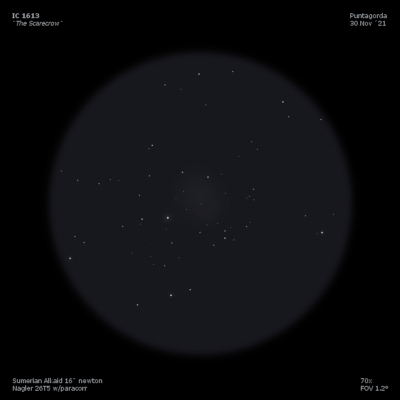
Max Wolf discovered IC 1613 on a plate taken with the Bruce 16-inch telescope in September 1906. Wolf's position (given in 1885 coordinates) is ~10' south and 1.5 minutes of time preceding the galaxy. As he used BD stars to measure positions, it's very possible the coordinates for the "densest part" are for 1855. If so, his position is near the center of IC 1613!
William Baade first showed it was extragalactic in 1935 and a year later Hubble included it as a Local Group member. The distance is ~2.4 million light years.
300/350mm - 13.1" (12/22/84): faint, large, extremely diffuse. This Local Group member appears as an irregular hazy region with a large brighter section to the NE and a fainter section to the SW. No visible core. Several brighter stars are in the field includes a star at the SW edge. Located 46' N of 26 Ceti.
400/500mm - 18" (9/15/07): faint, very large, irregular glow, roughly elongated 4:3 SW-NE, ~8'x6'. A mag 10.5 star is just at the west edge of the glow. A very small knot (HII region?) or core is faintly visible just 2' E or ENE of the mag 10.5 star. There appears to be a very faint detached piece to the northeast about 7' from the mag 10.5 star. Located ~12' S of mag 7.2 HD 6375.
900/1200mm - 48" (10/26/16): I spent a few minutes identifying OB associations in the patchy northeast section section of IC 1613. At 375x I was able to pinpoint a half-dozen faint or fairly faint "knots", generally 12"-15" in diameter within a 1.5' region. The identifications below are from Paul Hodge's 1978 study "The structure and content of IC 1613" and the Borissova et al. 2004 paper "The catalogue of OB associations in IC 1613".
[H78] 10 = [BKG04] G7, the brightest patch, is on the west edge and seen as moderately bright, small, 12" diameter. A star or stellar object is involved. Close northeast and southeast are [H78] 13 = [BKG2004] G11 and [H78] 14 = [BKG2004] G14, both easily seen as fairly faint glows, ~15" diameter. [H78] 17 = [BKG2004] G25 is very faint knot 1' E of [H78] 13 and [H78] 15 = [BKG2004] G15 was visible 30" S of [H78] 14. [H78] 11 = [BKG2004] G10 was also easily seen as a 12" knot 1.5' N of [H78] 10.
Notes by Steve Gottlieb